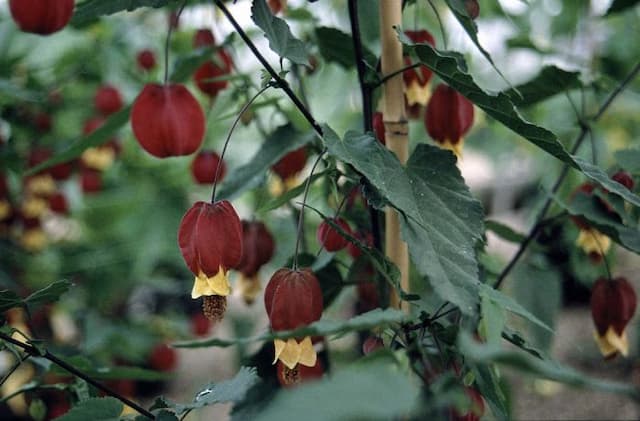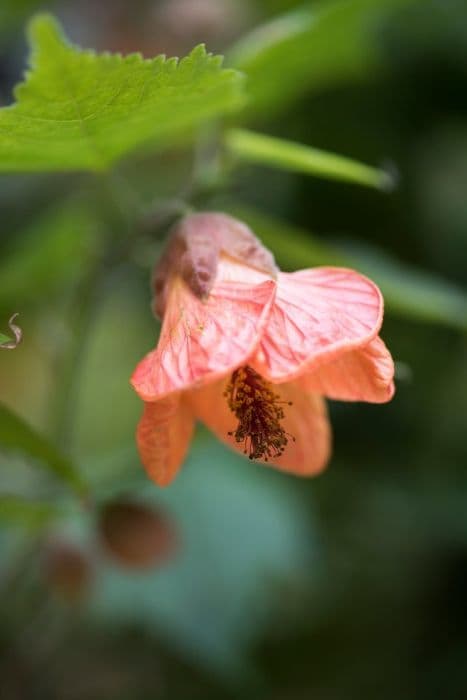Mongolian Lime Tilia mongolica

ABOUT
The Tilia mongolica, commonly known as the Mongolian lime tree, displays a lovely array of heart-shaped leaves which are asymmetrical at the base. These leaves boast a rich green hue on the upper side while the underside is covered with fine downy hairs giving it a lighter appearance. During the blooming season, the Mongolian lime tree produces small, fragrant flowers that are creamy-white, attracting bees and other pollinators with their sweet scent. These flowers hang in delicate clusters from a leafy bract, and upon pollination, they give way to small, round fruits that are inconspicuous and not commonly harvested. The bark of the Mongolian lime tree adds to its ornamental value, with its texture and color changing as the tree matures, providing visual interest throughout the year. Overall, this tree is appreciated for its shade, ornamental flowers and foliage, as well as the pleasant aroma of its flowers.
About this plant
 Names
NamesFamily
Malvaceae
Synonyms
Mongolian Lime, Mongolian Linden
Common names
Tilia mongolica.
 Toxicity
ToxicityTo humans
The Mongolian Lime (Tilia mongolica) is not generally known to be toxic to humans. There is no widespread evidence that suggests consumption of this plant causes poisoning in humans. Therefore, there are no specific symptoms associated with poisoning from this plant for humans because it is not considered poisonous.
To pets
The Mongolian Lime (Tilia mongolica) does not have a reputation for being toxic to pets. It is not typically listed among plants that are poisonous to domestic animals, so there are no specific symptoms of poisoning associated with this plant for pets. Consuming this plant is not expected to lead to toxic consequences for pets.
 Characteristics
CharacteristicsLife cycle
Perennials
Foliage type
Deciduous
Color of leaves
Green
Flower color
Yellow
Height
30 feet (9 meters)
Spread
20 feet (6 meters)
Plant type
Tree
Hardiness zones
4
Native area
Mongolia
Benefits
 General Benefits
General Benefits- Shade Provider: Tilia mongolica, commonly known as Mongolian Lime, offers broad canopy coverage that creates significant shade, making it ideal for parks and large gardens.
- Aesthetic Appeal: With its attractive heart-shaped leaves and spreading form, Mongolian Lime adds visual interest and beauty to the landscape.
- Habitat for Wildlife: It serves as a habitat and food source for various species of birds and insects, contributing to biodiversity.
- Windbreak: The dense foliage and strong branches can act as a windbreak, protecting smaller plants and reducing wind speeds in its vicinity.
- Soil Stabilization: The root system of Mongolian Lime helps in stabilizing the soil and preventing erosion.
- Urban Tolerant: It is tolerant of urban conditions, including pollution and compacted soils, making it suitable for city planting.
- Seasonal Interest: Offers seasonal interest with its spring flowers and autumn leaf color, providing year-round visual interest.
 Medical Properties
Medical Properties- Sedative: Tilia mongolica, often referred to as Mongolian Lime or Mongolian Linden, is traditionally used for its sedative properties to promote relaxation and sleep.
- Anxiolytic: The plant may also help reduce anxiety, similar to other members of the Tilia genus.
- Antispasmodic: It is used to alleviate muscle spasms or cramps.
- Diaphoretic: Helps induce sweating and is sometimes used in the treatment of fevers.
- Anti-inflammatory: Tilia mongolica may have anti-inflammatory properties, useful in reducing inflammation in the body.
- Expectorant: The plant might be used to treat respiratory conditions by helping to expel mucus from the airways.
 Air-purifying Qualities
Air-purifying QualitiesThis plant is not specifically known for air purifying qualities.
 Other Uses
Other Uses- The wood of the Tilia mongolica, commonly known as the Mongolian lime tree, is soft and light, often used in carving and for making wooden toys due to its easy workability.
- The inner bark fibers (bast) can be used to produce ropes, mats, and other woven goods traditionally.
- The tree's flowers are a source of nectar for bees, and thus, the Mongolian lime helps support local beekeeping industries.
- Leaves from the Mongolian lime can be used as a natural dye, imparting a green color to fabrics when appropriately processed.
- The dense, heart-shaped foliage provides excellent shade and creates comfortable outdoor seating areas during the summer months.
- Linden wood from Tilia mongolica trees is suitable for creating musical instruments such as guitars and woodwinds due to its tonal qualities.
- Flowers from the tree can be dried and added to potpourris for a natural, fresh fragrance indoors.
- The sap from Mongolian lime trees can be collected and used as a base for certain types of natural adhesives and varnishes.
- Historically, the tree's soft wood has been used to make lightweight panels for carriages and coaches.
- In landscape architecture, the plant is used for its symmetrical growth pattern, which makes it an aesthetically pleasing choice for garden design and street lining.
Interesting Facts
 Feng Shui
Feng ShuiThe Mongolian Lime is not used in Feng Shui practice.
 Zodiac Sign Compitability
Zodiac Sign CompitabilityThe Mongolian Lime is not used in astrology practice.
 Plant Symbolism
Plant Symbolism- Love: Tilia, commonly known as lime or linden trees, are often associated with love and fidelity, possibly due to their heart-shaped leaves and the longevity of the tree.
- Peace: The linden tree is a symbol of peace and tranquility, which stems from its traditional use as a community gathering place or a site of judicial proceedings under its canopy.
- Friendship: As a social hub in historical times, linden trees signify strong community ties and are therefore often linked to the theme of friendship.
- Healing: Due to the medicinal properties found in linden flowers and bark, which have been used to soothe anxiety and aid sleep, the tree symbolizes healing.
- Justice: In ancient Germanic culture, legal assemblies and court sessions were often held beneath linden trees, which came to represent justice and fairness.
- Domesticity: Because of its durability, ease of working, and traditional use in constructing family homes and domestic items, the linden tree can signify stability and domestic happiness.
 Water
WaterThe Mongolian Lime, commonly known as Tilia mongolica, should be watered deeply and slowly to ensure water reaches the root system; this should be done weekly during the growing season. Young trees require approximately 15-20 gallons of water per week, while established trees may require more or less depending on weather conditions. During hot, dry periods, increase watering frequency, but always allow the soil to dry out slightly between waterings. Over the winter months, reduce watering significantly, but do not allow the soil to become completely dry.
 Light
LightFor optimal growth, the Mongolian Lime requires full sun to partial shade. The ideal location would provide direct sunlight for at least 6 hours a day, while also offering some protection during the hottest part of the day. Ensuring that the tree receives ample light will contribute to healthy foliage and proper growth.
 Temperature
TemperatureThe Mongolian Lime can tolerate a range of temperatures, surviving minimums down to around -30 degrees Fahrenheit and maximums that typically don't exceed 85 degrees Fahrenheit. The ideal growing temperature for the tree is between 50 and 75 degrees Fahrenheit, ensuring healthy growth and development.
 Pruning
PruningPrune the Mongolian Lime in late winter or early spring before new growth begins to remove any dead, damaged, or diseased branches and to shape the tree. Pruning every two to three years is often sufficient to maintain tree health and desired form. Pruning also encourages airflow and light penetration, which are essential for the overall vitality of the tree.
 Cleaning
CleaningAs needed
 Soil
SoilThe Mongolian Lime prefers fertile, well-draining soil with pH ranging from 6.0 to 7.0. A mixture containing loam, peat, and coarse sand in equal parts is ideal for proper growth and nutrition.
 Repotting
RepottingMongolian Lime trees grown in containers should be repotted every 2 to 3 years to ensure they have enough space for root growth and access to fresh nutrients.
 Humidity & Misting
Humidity & MistingThe Mongolian Lime thrives in moderate to high humidity levels; ranging from 40% to 70% is considered ideal for the health of the plant.
 Suitable locations
Suitable locationsIndoor
Not suitable for indoor growth; requires outdoor space.
Outdoor
Ensure full sun, shelter from wind, and well-draining soil.
Hardiness zone
3-7 USDA
 Life cycle
Life cycleThe life cycle of the Mongolian lime (Tilia mongolica) begins with seed germination, which takes place in moist, fertile soil in spring after stratification throughout the winter. The seedling grows into a juvenile tree with a straight trunk and heart-shaped leaves, experiencing rapid vertical growth. After several years, the tree reaches maturity and starts to develop flowers in early summer, which are small, fragrant, and cream-colored, attracting pollinators such as bees. Following pollination, the tree produces small nut-like fruits, which are dispersed by wind due to the attached bract acting as a wing, allowing the cycle to continue. The Mongolian lime can live for many decades, with some specimens living well over a century, during which the tree will continue to bloom and produce seeds annually. Throughout its life span, the tree undergoes natural processes such as seasonal leaf fall and dormancy during the winter, ensuring survival in its native temperate climate zones.
 Propogation
PropogationPropogation time
Spring-early summer
The most popular method of propagation for the Mongolian Lime, or Tilia mongolica, is through seed sowing. Ideally, seeds should be collected once they mature in the fall and sown immediately as they exhibit dormancy. If immediate sowing is not possible, seeds can be stratified, which entails mimicking winter conditions by mixing them with slightly moist sand or peat moss and refrigerating them at roughly 41 degrees Fahrenheit (5 degrees Celsius) for one to four months before planting. Once stratified, seeds can be sown in a well-draining seed starting mix, lightly covered with soil, and kept moist. Seedlings will require protection from extreme temperatures and should be allowed to grow until they reach a suitable size for outplanting, typically after one or two growing seasons.









